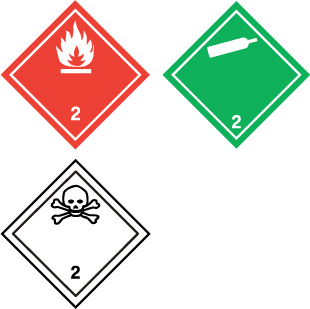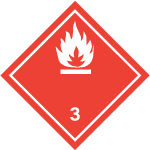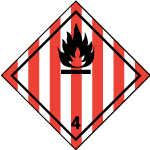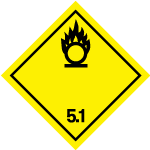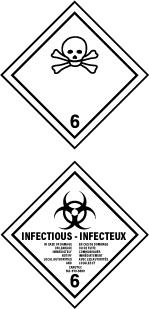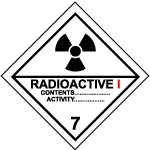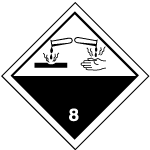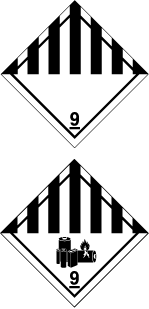Transportation of Dangerous Goods (TDG) - 9 Classes
On this page
What is the purpose of the TDG Act and Regulations?
Back to topThe purpose of the Transportation of Dangerous Goods (TDG) Act and Regulations is to promote public safety when dangerous goods are being handled, offered for transport or transported by road, rail, air, or water (marine). TDG also establishes safety requirements.
Note: The information below is provided as guidance only. Always check the TDG Act and Regulations to ensure compliance.
Please also see the following documents in this series:
How will I know what class a substance has been assigned to?
Back to topDangerous goods are classified into 9 classes, based on the substance’s characteristics and properties. These criteria are outlined in the TDG Regulations.
Assigning a substance into a hazard class is usually done by the consignor. The person deciding the classification must be competent, meaning they have the education, training, and experience required for the task. Some substances have been assigned classes in the TDG Regulations.
For more information on how classification works, please see the OSH Answers Transportation of Dangerous Goods (TDG) - Classification.
What are the main concerns for each class?
Back to topAlways consult the TDG Regulations for full details on classes, divisions, and exemptions. This table provides a general overview of each class.
| Class | Hazard | Examples |
| Class 1 Explosives | There are six divisions in this category. To be included, the substance or article has the ability to be a mass explosion, fragment projection, fire hazard (along with a minor blast or projection hazard), may ignite or initiate during transport, be very insensitive with a mass explosion hazard, or extremely insensitive with no mass explosion hazard. | •Ammonium picrate •Cartridges for weapons (with specific characteristics) •White phosphorus •Pyrotechnic substances |
| Class 2 Gases | There are three divisions: flammable gases, non-flammable and non-toxic gases, and toxic gases. Aerosols under UN 1950, AEROSOLS may be transported as flammable or non-flammable or non-toxic gases, depending on the properties of the aerosol. |
•Propane •Nitrogen •Carbon dioxide Oxygen, compressed •Oxygen, refrigerated liquid •Chlorine •Sulphur dioxide |
| Class 3 Flammable Liquids | Based on a liquid’s flash point and other properties, substances are included in this class if they are expected to be able to catch fire at common temperatures. | •Gasoline •Diesel •Methanol |
| Class 4 Substances/Products include: Flammable Solids; Substances Liable to Spontaneous Combustion; Substances That on Contact with Water Emit Flammable Gases (Water-reactive Substances) | Class 4 has three divisions: flammable solids, substances liable to spontaneous combustion, and water reactive substances. These substances may cause fire (through friction), become explosive when in contact with water, become explosive even with contact with oxygen (air), or undergo a reaction that will result in a stronger exothermic reaction (a reaction that releases heat). For example, Class 4.2 Substances liable to spontaneous combustion includes substances that will ignite within 5 minutes of coming in to contact with air. |
•Sulphur •Safety matches •Naphthalene •Carbon, activated •Calcium carbide |
| Class 5 Oxidizing Substances, including Organic Peroxides | The two divisions are oxidizing substances and organic peroxides. These substances may explosively decompose, burn rapidly, be sensitive to impact or friction, react dangerously with other substances, or cause damage to the eyes. |
•Ammonium nitrate based fertilizer •Hydrogen peroxide •Dibenzoyl peroxide |
| Class 6 Toxic and Infectious Substances | The two divisions are toxic substances and infections substances. Substances are included in class 6 if they can cause death or serious injury or harm to human health if swallowed, inhaled, or in contact with skin. Medical or clinical waste may also be classified as an infectious substance if they contain regulated properties. |
•Strychnine •Arsenic •Chloroform •Phenol •Bacteria •Viruses |
| Class 7 Radioactive Materials | Radioactive materials include those substances included in the Packaging and Transport of Nuclear Substances Regulations. | •Items with tritium concentrations |
| Class 8 Corrosive Substances | There are no divisions in this class. Substances are included in Class 8 if they are known to cause injury to the skin such as burns, destruction (thickness), or lesions. | •Acetic acid •Sulphuric acid |
| Class 9 Miscellaneous Products, Substances or Organisms | Substances are considered Class 9 when they are listed in column 3 of Schedule 1 in the TDG Regulation, or by other inclusions and exclusions as defined in the regulations. Substances include those that present a danger sufficient to be included in the TDG regulations, but which cannot be assigned to any other class. |
•Carbon dioxide, solid (Dry Ice) •Lithium cells and batteries |
What are the safety marks for each class?
Back to topThe size, shape and colour of the required safety marks are outlined in the TDG Regulations.
The following table shows common safety marks for each class. To view all the required safety marks, please see the “Marks of Safety” from Transport Canada.
| Class | Sample Safety Mark(s) |
| Class 1 Explosives | 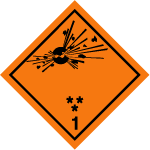
Sample shows: Class 1.1., 1.2 and 1.3 |
| Class 2 Gases |
Samples show: Class 2.1 Flammable gases; Class 2.2 Non-flammable and non-toxic gases; Class 3 Toxic gases |
| Class 3 Flammable Liquids |
Sample shows: Class 3 Flammable liquids |
| Class 4 Substances/Products include: Flammable Solids; Substances Liable to Spontaneous Combustion; Substances That on Contact with Water Emit Flammable Gases (Water-reactive Substances) |
Sample shows: Class 4.1 Flammable solids |
| Class 5 Oxidizing Substances, including Organic Peroxides |
Sample shows: Glass 5.1 Oxidizing substances |
| Class 6 Toxic and Infectious Substances |
Samples show: Class 6.1 Toxic substances; Class 6.1 Infectious substances |
| Class 7 Radioactive Materials |
Sample shows Class 7 Radioactive materials, |
| Class 8 Corrosive Substances |
Sample shows Class 8 Corrosives |
| Class 9 Miscellaneous Products, Substances or Organisms |
Samples show: Class 9 Miscellaneous Products, Substances or Organisms; Class 9 Lithium Batteries |
- Fact sheet first published: 2021-02-15
- Fact sheet last revised: 2021-02-15

